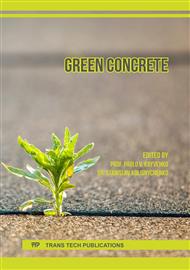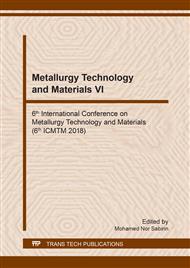[1]
Y. Wang, H.C. Wu and V.C. Li, Concrete reinforcement with recycled fibers, J. of Materials in Civil Eng. 12 (4) (2000) 314-319.
Google Scholar
[2]
M. Ahmed, J. Mallick and M.A. Hasan, A study of factors affecting the flexural tensile strength of concrete, Journal of King Saud University – Eng. Sci. 28 (2) (2016) 147-156.
DOI: 10.1016/j.jksues.2014.04.001
Google Scholar
[3]
A. Sofi and B.R. Phanikumar, An experimental investigation on flexural behaviour of fibre-reinforced pond ash-modified concrete, Ain Shams Eng. J. 6 (2015) 1133-1142.
DOI: 10.1016/j.asej.2015.03.008
Google Scholar
[4]
A.T. Noaman, B.H. Abu Bakar and H. Md. Akil, Experimental investigation on compression toughness of rubberised steel fibre concrete. Constr. and Building Materials 115 (2016) 163-170.
DOI: 10.1016/j.conbuildmat.2016.04.022
Google Scholar
[5]
K. Aarthi and K. Arunachalam, Durability studies on fibre reinforced self compacting concrete with sustainable wastes. J. of Cleaner Production 174 (2018) 247-255.
DOI: 10.1016/j.jclepro.2017.10.270
Google Scholar
[6]
M.A.B. Emon, T. Manzur and M.S. Sharif, Suitability of locally manufactured galvanised iron (GI) wire fiber as reinforcing fiber in brick chip concrete. Case Studies in Constr. Materials 7 (2017) 217-227.
DOI: 10.1016/j.cscm.2017.08.003
Google Scholar
[7]
R.I. Gilbert and E.S. Bernard, Post-cracking ductility of fibre reinforced concrete linings in combined bending and compression. Tunnelling and Underground Space Tech. 76 (2018) 1-9.
DOI: 10.1016/j.tust.2018.02.010
Google Scholar
[8]
C. High, H.M. Seliem, A. El-Safty and S.H. Rizkalla, Use of basalt fibers for concrete structures. Constr. and Building Materials 96 (2015) 37-46.
DOI: 10.1016/j.conbuildmat.2015.07.138
Google Scholar
[9]
A.C. Bhogayata and N.K. Arora, Fresh and strength properties of concrete reinforced with metalized plastic waste fibers. Constr.and Building Materials 146 (2017) 455-463.
DOI: 10.1016/j.conbuildmat.2017.04.095
Google Scholar
[10]
W. Abbass, M.I. Khan and S. Mourad, Evaluation of mechanical properties of steel fiber reinforced concrete with different strengths of concrete. Constr. and Building Materials 168 (2018) 556-569.
DOI: 10.1016/j.conbuildmat.2018.02.164
Google Scholar
[11]
A.S.M. Abdul Awal and H. Mohammadhosseini, Green concrete production incorporating waste carpet fiber and palm oil fuel ash. J. of Cleaner Production 137 (2016) 157-166.
DOI: 10.1016/j.jclepro.2016.06.162
Google Scholar
[12]
P. Kumar and R. Roy, Study and experimental investigation of flow and flexural properties of natural fiber reinforced self compacting concrete. Procedia Computer Sci. 125 (2018) 598-608.
DOI: 10.1016/j.procs.2017.12.077
Google Scholar
[13]
G.S. Vijaya, V.G. Ghorpade and H.S. Rao, The behaviour of self compacting concrete with waste plastic fibers when subjected to chloride attack. Materials Today: Proceedings 5 (2018) 1501-1508.
DOI: 10.1016/j.matpr.2017.11.239
Google Scholar
[14]
N. Ristic, G. Toplicic-curcic and D. Grdic, Abrasion resistance of concrete made with micro fibers and recycled granulated rubber. Zastita Materijala 56 (4) (2015).
DOI: 10.5937/zasmat1504435r
Google Scholar
[15]
V. Sangrutsamee, P. Srichandr and N. Poolthong, Re-pulped waste paper-based composite building materials with low thermal conductivity. J. of Asian Architecture and Building Eng. 151 (2012) 147-151.
DOI: 10.3130/jaabe.11.147
Google Scholar
[16]
B. Poojitha and S.B. Pravallika, Study on partial replacement of cement with waste paper sludge ash in fibre reinforced concrete. Int. J. of Eng. Sci. and Computing 7 (5) (2017) 11329-11335.
DOI: 10.21275/art20175791
Google Scholar
[17]
Z. Jiang, X. Guo, W. Li and Q. Chen, Self-shrinkage behavior of waste paper fiber reinforced cement paste considering its self-curing effect at early-ages. Int. J. of Polymer Sci. (2016) 1-11.
DOI: 10.1155/2016/8690967
Google Scholar
[18]
I. Merta and E.K. Tschegg, Fracture energy of natural fibre reinforced concrete. Constr. and Building Materials 40 (2013) 991-997.
DOI: 10.1016/j.conbuildmat.2012.11.060
Google Scholar
[19]
A. Alsaif, L. Koutas, S.A. Bernal, M. Guadagnini and K. Pilakoutas, Mechanical performance of steel fibre reinforced rubberised concrete for flexible concrete pavements. Constr. and Building Materials 172 (2018) 533-543.
DOI: 10.1016/j.conbuildmat.2018.04.010
Google Scholar
[20]
M. Safiuddin, M. Yakhlaf and K.A. Soudki, Key mechanical properties and microstructure of carbon fibre reinforced self-consolidating concrete. Constr. and Building Materials 164 (2018) 477-488.
DOI: 10.1016/j.conbuildmat.2017.12.172
Google Scholar
[21]
A. Razmi and M.M. Mirsayar, On the mixed mode I/II fracture properties of jute fiber-reinforced concrete. Constr. and Building Materials 148 (2017) 512-520.
DOI: 10.1016/j.conbuildmat.2017.05.034
Google Scholar
[22]
W. Wang and N. Chouw, The behaviour of coconut fibre reinforced concrete (CFRC) under impact loading. Constr. and Building Materials 134 (2017) 452-461.
DOI: 10.1016/j.conbuildmat.2016.12.092
Google Scholar
[23]
K. Yantaboot and T. Amornsakchai, Effect of mastication time on the low strain properties of short pineapple leaf fiber reinforced natural rubber composite. Polymer Testing 57 (2017) 31-37.
DOI: 10.1016/j.polymertesting.2016.11.006
Google Scholar
[24]
A.S. Wahyuni, F. Supriani, Elhusna and A. Gunawan, The performance of concrete with rice husk ash, sea shell ash and bamboo fibre addition. Procedia Eng. 95 (2014) 473-478.
DOI: 10.1016/j.proeng.2014.12.207
Google Scholar
[25]
G.H. Kumar, H. Babuvishwanant, R. Purohit, P. Sahu and R.S. Rana, Investigations on mechanical properties of glass and sugarcane fiber polymer matrix composites. Materials Today: Proceedings 4 (2017) 5408-5420.
DOI: 10.1016/j.matpr.2017.05.052
Google Scholar



